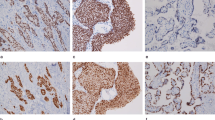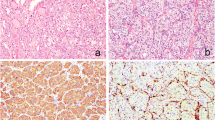Abstract
Pheochromocytoma usually shows prominent nuclear atypia, but the presence of such atypical cells is known to be an unreliable predictor of malignancy. DNA ploidy of pheochromocytomas has been analyzed by flow cytometry or photospectrometry on paraffinem-bedded tissue, but the results were controversial. We performed DNA analysis on cytology specimens of 11 pheochromocytomas using an image analysis system. All tumors had a mixed pattern of a large population of diploid cells and a small population of polyploid cells. DNA content correlated with nuclear size, and larger cells had more DNA content. Such larger tumor cells had polyploid nuclei, such as 4 C, 8 C, 16 C, and 32 C, in both malignant and benign pheochromocytomas. The larger polyploid nuclei may result from difficulty of duplication at the mitotic phase of the cell cycle.
Similar content being viewed by others
References
Amberson J, Gray G, Vaugham E, et al. DNA flow cytometry of 22 adrenal pheo-chromocytomas using paraffin-embedded archival materials. Lab Invest 54:3A, 1986.
Bacus JW, Grace LJ. Optical microscope system for standardized cell measurements and analyses. Appl Optics 26:3280–3293, 1987.
Clemo FAS, Crabtree WN, Walker E, DeNicola DB. Comparison of image analysis and flow cytometric measurements of DNA content of canine transitional cell carcinomas. Anal Quant Cytol Histol 15:418–426, 1993.
Gonzalez-Campora R, Diaz-Cano S. Lerma-Puertas E, Rios-Martin JJ, Salguero-Villadiego M, Villar-Rodoriguetz JL, Bibbo M, Davidson HG. Paragangliomas. Statistic cytometric studies of nuclear DNA patterns. Cancer 71:820–824, 1993.
Gurley AM, Hidvegi DF, Bacus JW, Bacus SS. Comparison of the Papanicolaou and Feulgen staining methods for DNA quantification by image analysis. Cytometry 11:466–474, 1990.
Hosaka Y, Aso Y, Rainwater LM, Grant CS, Farrow GM, van-Heerden JA, Lieber MM. Flow cytometric DNA histograms of paraffin-embedded pheochromocytomas. Urol Int 47(suppl 1):100–103, 1991.
Itakura H,, Kinoshita K, Munakata A, Takamoto S, Minowada S, Aso Y. Flow cytometric analysis of DNA aneuploidy in adrenal tumors. Nippon Hinyokika Gakkai Zasshi 83:53–58, 1992.
Kimura N, Sasano N. A comparative study between malignant and benign pheochromocytoma using morphometry, cytophotometry, and immunohistochemistry. In Lechago J, Kameya T, eds. Endocrine pathology update, vol 1. Field &Wood, New York: 1990, 99–118.
Kino I, Richart RM, Lattes R. Nuclear DNA in salivary gland tumors. Arch Pathol 95:245–251, 1973.
Koss LG, Czerniak B, Herz F, Wersto RP. Flow cytometric measurements of DNA and other cell components in human tumors: A critical appraisal. Hum Pathol 20:529–548, 1989.
Lewis PD. A cytophotometric study of benign and malignant pheochromocytomas. Virchow Archiv [B] 9:371–376, 1971.
Linnoila RI, Keiser HR, Steinberg SM, Lack E. Histopathology of benign versus malignant sympathoadrenal paragangliomas: clinicopathologic study of 120 cases including unusual histologic features. Hum Pathol 21:1168–1180, 1990.
Medeiros LJ, Wolf BC, Balogh K, Federman M. Adrenal pheochromocytoma: a clinicopathologic review of 60 cases. Hum Pathol 16:580–589, 1985.
Nativ O, Grant CS, Sheps SG, O’Fallon JR, Farrow GM, van-Heerden JA, Lieber MM. The clinical significance of nuclear DNA ploidy pattern in 184 patients with pheochromocytoma. Cancer 69:2683–2687, 1992.
Proye C, Vix M, Goropoulos A, Kerlo P, Lecomte-Houcke M. High incidence of malignant pheochromocytoma in a surgical unit. 26 cases out of 100 patients operated from 1971 to 1991. J Endocrinol Invest 15:651–653, 1992.
Author information
Authors and Affiliations
Rights and permissions
About this article
Cite this article
Kimura, N., Watanabe, M., Ookuma, T. et al. Dna ploidy of pheochromocytoma on cytology specimen by image analysis. Endocr Pathol 5, 178–182 (1994). https://doi.org/10.1007/BF02921474
Published:
Issue Date:
DOI: https://doi.org/10.1007/BF02921474




